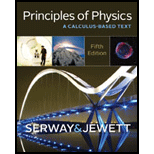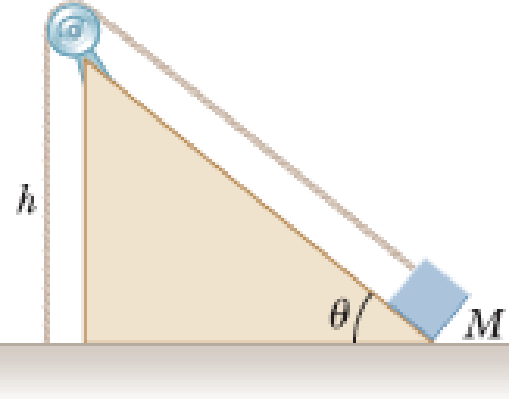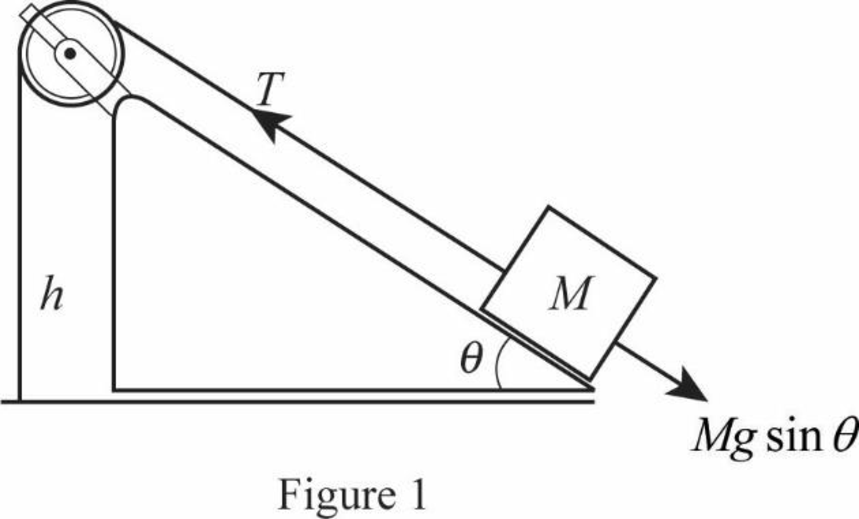
Concept explainers
Review. For the arrangement shown in Figure P14.60, the inclined plane and the small pulley are frictionless; the string supports the object of mass M at the bottom of the plane; and the string has mass m. The system is in equilibrium, and the vertical part of the string has a length h. We wish to study standing waves set up in the vertical section of the string. (a) What analysis model describes the object of mass M? (b) What analysis model describes the waves on the vertical part of the string? (c) Find the tension in the string. (d) Model the shape of the string as one leg and the hypotenuse of a right triangle. Find the whole length of the string. (e) Find the mass per unit length of the string. (f) Find the speed of waves on the string. (g) Find the lowest frequency for a standing wave on the vertical section of the string. (h) Evaluate this result for M = 1.50 kg, m = 0.750 g, h = 0.500 m, and θ = 30.0°. (i) Find the numerical value for the lowest frequency for a standing wave on the sloped section of the string.
Figure P14.60

(a)
The analysis model
Answer to Problem 60P
The object is described using constant acceleration model.
Explanation of Solution
The mass of the object supported by the string is
The object of mass
Conclusion:
Therefore, the object of mass
(b)
The analysis model
Answer to Problem 60P
The waves on the vertical part of the string can be described using the waves under boundary conditions model.
Explanation of Solution
The mass of the object supported by the string is
The vertical portion of the string is fixed at both the ends hence the boundary conditions stand for the waves. Write the general equation for the wavelength on the string.
Here,
Conclusion:
Therefore, the waves on the vertical part of the string can be described using the waves under boundary conditions model.
(c)
The tension on the string
Answer to Problem 60P
The tension on the string is
Explanation of Solution
Figure.1 shows the arrangement of the mass-pulley system.

Write the equation for the net force acting on the mass.
Here,
Conclusion:
Re-write the equation (I) such that the net force is zero.
Therefore, the tension on the string is
(d)
The length of the string
Answer to Problem 60P
The length of the string is
Explanation of Solution
Write the equation for the sine of the angle of inclination.
Rewrite the equation (I) to find the equation for the
Write the equation for the total length of the string.
Conclusion:
Substitute equation (II) in equation (III).
Therefore, the length of the strings is
(e)
The mass per unit length of the string
Answer to Problem 60P
The mass per unit length of the string is
Explanation of Solution
Write the equation for the mass per unit length of the string.
Here,
Conclusion:
Substitute equation (V) in equation (VI).
Therefore, the mass per unit length of the string is
(f)
The speed of waves on the string
Answer to Problem 60P
The speed of waves on the string is
Explanation of Solution
Write the equation for the speed of the waves on the string.
Here,
Conclusion:
Substitute equation (II) and equation (VIII) in equation (IX).
Therefore, the speed of the waves on the string is
(g)
The lowest frequency for a standing wave
Answer to Problem 60P
The lowest frequency for the standing waves is
Explanation of Solution
The length
Write the equation for the frequency of the standing wave.
Here,
Conclusion:
Substitute equation (X) and equation (XI) in equation (XII).
Therefore, the lowest possible frequency of the standing waves is
(h)
The lowest frequency for a set of given values
Answer to Problem 60P
The lowest frequency for the standing waves is
Explanation of Solution
Write the equation for the lowest frequency of the standing wave from equation (XIII).
Conclusion:
Substitute
Therefore, the lowest frequency of the standing waves is
(i)
The lowest frequency on the sloped section
Answer to Problem 60P
The lowest frequency for the standing waves on the sloped section is
Explanation of Solution
The wavelength of the fundamental mode of vibration is twice the length of the sloped section.
Here,
Substitute equation (X) and equation (XIV) in equation (XII).
Substitute
Therefore, the lowest frequency of the standing waves is
Want to see more full solutions like this?
Chapter 14 Solutions
Principles of Physics
- Review. A sphere of mass M is supported by a string that passes over a pulley at the end of a horizontal rod of length L (Fig. P14.25). The string makes an angle θ with the rod. The fundamental frequency of standing waves in the portion of the string above the rod is f. Find the mass of the portion of the string above the rod. Figure P14.25 Problems 25 and 26.arrow_forwardA string with a mass m = 8.00 g and a length L = 5.00 m has one end attached to a wall; the other end is draped over a small, fixed pulley a distance d = 4.00 m from the wall and attached to a hanging object with a mass M = 4.00 kg as in Figure P14.21. If the horizontal part of the string is plucked, what is the fundamental frequency of its vibration? Figure P14.21arrow_forwardAs in Figure P18.16, a simple harmonic oscillator is attached to a rope of linear mass density 5.4 102 kg/m, creating a standing transverse wave. There is a 3.6-kg block hanging from the other end of the rope over a pulley. The oscillator has an angular frequency of 43.2 rad/s and an amplitude of 24.6 cm. a. What is the distance between adjacent nodes? b. If the angular frequency of the oscillator doubles, what happens to the distance between adjacent nodes? c. If the mass of the block is doubled instead, what happens to the distance between adjacent nodes? d. If the amplitude of the oscillator is doubled, what happens to the distance between adjacent nodes? FIGURE P18.16arrow_forward
- Review. A light string with a mass per unit length of 8.00 g/m has its ends tied to two walls separated by a distance equal to three-fourths the length of the string (Fig. P13.18). An object of mass m is suspended from the center of the string, putting a tension in the string. (a) Find an expression for the transverse wave speed in the string as a function of the mass of the hanging object. (b) What should be the mass of the object suspended from the string if the wave speed is to be 60.0 m/s? Figure P13.18arrow_forwardReview. A block of mass M, supported by a string, rests on a frictionless incline making an angle with the horizontal (Fig. P13.50). The length of the string is L, and its mass is m M. Derive an expression for the time interval required for a transverse wave to travel from one end of the string to the other. Figure P13.50arrow_forwardA block of mass m = 5.00 kg is suspended from a wire that passes over a pulley and is attached to a wall (Fig. P17.71). Traveling waves are observed to have a speed of 33.0 m/s on the wire. a. What is the mass per unit length of the wire? b. What would the speed of waves on the wire be if the suspended mass were decreased to 2.50 kg? FIGURE P17.71arrow_forward
- Review. A sphere of mass M is supported by a string that passes over a pulley at the end of a horizontal rod of length L (Fig. P17.15). The string makes an angle with the rod. The fundamental frequency of standing waves in the portion of the string above the rod is f. Find the mass of the portion of the string above the rod.arrow_forwardThe string shown in Figure P13.5 is driven at a frequency of 5.00 Hz. The amplitude of the motion is A = 12.0 cm, and the wave speed is v = 20.0 m/s. Furthermore, the wave is such that y = 0 at x = 0 and t = 0. Determine (a) the angular frequency and (b) the wave number for this wave. (c) Write an expression for the wave function. Calculate (d) the maximum transverse speed and (e) the maximum transverse acceleration of an element of the string. Figure P13.5arrow_forwardReview. Consider the apparatus shown in Figure P14.68a, where the hanging object has mass M and the string is vibrating in its second harmonic. The vibrating blade at the left maintains a constant frequency. The wind begins to blow to the right, applying a constant horizontal force on the hanging object. What is the magnitude of the force the wind must apply to the hanging object so that the string vibrates in its first harmonic as shown in Figure 14.68b? Figure P14.68arrow_forward
 Principles of Physics: A Calculus-Based TextPhysicsISBN:9781133104261Author:Raymond A. Serway, John W. JewettPublisher:Cengage Learning
Principles of Physics: A Calculus-Based TextPhysicsISBN:9781133104261Author:Raymond A. Serway, John W. JewettPublisher:Cengage Learning Physics for Scientists and Engineers, Technology ...PhysicsISBN:9781305116399Author:Raymond A. Serway, John W. JewettPublisher:Cengage Learning
Physics for Scientists and Engineers, Technology ...PhysicsISBN:9781305116399Author:Raymond A. Serway, John W. JewettPublisher:Cengage Learning Physics for Scientists and EngineersPhysicsISBN:9781337553278Author:Raymond A. Serway, John W. JewettPublisher:Cengage Learning
Physics for Scientists and EngineersPhysicsISBN:9781337553278Author:Raymond A. Serway, John W. JewettPublisher:Cengage Learning Physics for Scientists and Engineers with Modern ...PhysicsISBN:9781337553292Author:Raymond A. Serway, John W. JewettPublisher:Cengage Learning
Physics for Scientists and Engineers with Modern ...PhysicsISBN:9781337553292Author:Raymond A. Serway, John W. JewettPublisher:Cengage Learning Physics for Scientists and Engineers: Foundations...PhysicsISBN:9781133939146Author:Katz, Debora M.Publisher:Cengage Learning
Physics for Scientists and Engineers: Foundations...PhysicsISBN:9781133939146Author:Katz, Debora M.Publisher:Cengage Learning




